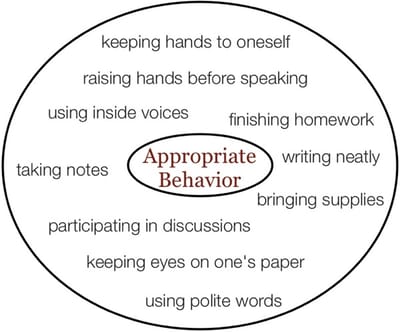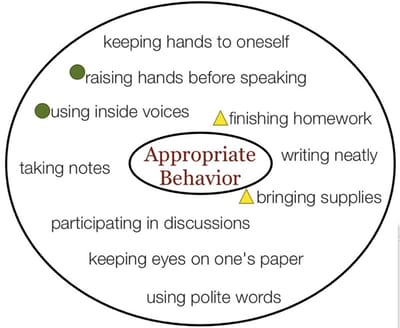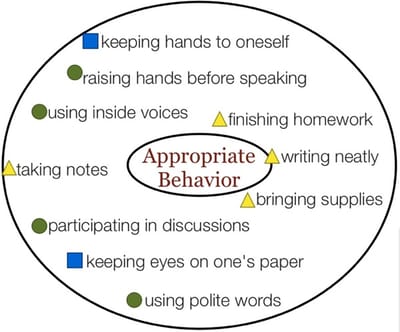Inductive lessons are a wonderful way to get your students thinking. They have no “correct” answer, lead to unexpected discussions, and give students’ ownership of their work. Rather than coming together to one understanding, your students will spread out, arriving at different conclusions.
I wrote previously about inductive lessons using the Nile River as an example.
The Steps
This idea uses Hilda Taba‘s inductive model, which follows these steps:
- Brainstorm unorganized examples
- Ask students to pair examples up (without stating why)
- Build larger groups of examples
- After all examples are grouped, label the groups
- Create a sentence built from the labels
School Rules
I used these steps to create classroom mottos in the beginning of the school year. It was a novel way to explore expectations by building on students’ own knowledge.
1. Brainstorm Examples
First, the class brainstormed examples of “appropriate school behavior.” This led to dozens of details, including:
- raising hands before speaking
- using inside voices
- finishing homework
- keeping hands to oneself
- bringing supplies
- using polite words
- keeping eyes on one’s paper
- participating in discussions
- taking notes
- writing neatly
And so on…
Whenever you hit a lull in the brainstorming process, let the silence continue for longer than is comfortable. Then, suddenly, someone will have a new, and often unusual, idea. This will jumpstart the class’ thinking. So, don’t be afraid to sit in awkward silence between ideas. You want a nice wide variety of ideas on your graphic organizer.

2. Pair Examples
Once you’ve finished brainstorming, ask your class:
What are two items that go together?
Students might say “inside voices” and “raise your hand” go together. Don’t ask why. You want to keep students’ minds open. If you label the groups now, kids will converge to one idea rather than diverging to multiple ideas.
To promote the idea of “no labels,” just use a symbol to represent groups. A star, a circle, or a square are great labels that don’t have a specific meaning.

Then, start a second pairing.
What are two items that go together, but don’t go with these two?
Students might say: “bringing supplies” and “finishing homework.” Put a new graphical label next to those two items.
3. Continue Grouping
You can continue as a whole group (better for younger students), but I love to break students into smaller groups at this point. Each group will continue grouping items, but they’ll come to deliciously different conclusions. They might add: “using polite words” to our first pair. Or they might create a completely new group.
If your students are new at this, keep reinforcing that there is no right answer. Encourage divergent thinking.
Tip: If you break the students into groups, send a student up to the office to make copies of the big brainstorm. Then each group can have their own copy to work with. Or, type the ideas into your computer rather than writing them on the board, and then you can just print several copies.

4. Labels
Once all items have been grouped, then tell students to label the groups. These labels should be one to three words, not complete sentences. We’re going to combine the labels to build our final, abstract statements.
Here are some possible labels:
- Group Interactions
- Responsibilities
- Working Hard
- Controlling Our Voices
- Helping Each Other
Each group of students will probably come up with a different set of labels. This is great and shows that they are exploring their own understanding of the data.
5. The Sentence
In the last step, students will form a sentence that includes each of their labels. The sentence will be an abstract summary of appropriate school behavior and could become a “class motto.”
If you have students working in groups, they’ll all create slightly different sentences. Discuss and post them all.
Here are a couple examples, with labels in bold:
- “This year, we’re working hard on our own responsibilities as well as our group interactions.”
- “In the classroom, we should control our voices, work hard, but also be creative.”
- “Scholars should come prepared, respect their peers, and try their hardest.
Inductive Thinking as an Opener
This example shows how the inductive model of instruction works well as a unit opener, building on student’s prior knowledge and opening them up to think deeper about a topic.
But, inductive thinking is also a perfect way to end a unit. In this way, inductive thinking wraps up all the details students have learned and asks them to condense it into larger and broader statements. My earlier article on the Nile River shows this technique in action.
Please let me know how you use the inductive model with your students: ian@byrdseed.com.
Related Videos For Byrdseed.TV Members

